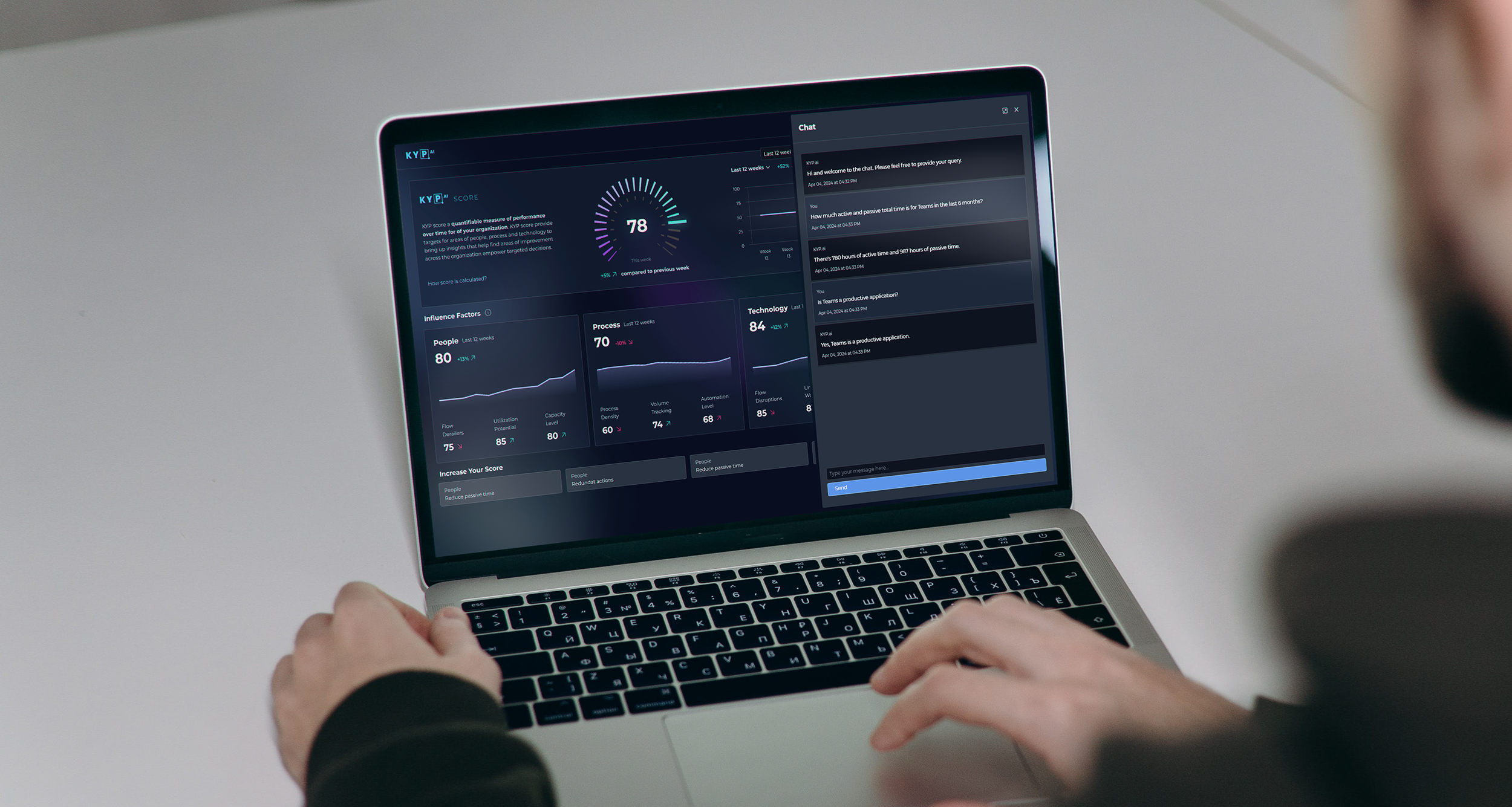Financial and banking leaders are under increasing pressure to demonstrate process excellence outcomes achieved with automation tools. McKinsey and Company predict that banking will have one of the largest opportunities for productivity gains with Gen AI.
And while the benefits of process excellence are possible, a challenge with promising statistics like this is overstated simplicity.
Adding software (even Gen AI) does not guarantee that positive results will follow.
Below, are a curated series of concrete and actionable case studies, specifically tailored for finance and banking executives. These narratives are not only replicable and scalable, but also quantifiable in their impact. They highlight practical strategies that finance and banking professionals can adopt to not only meet but also exceed their process excellence objectives.
Can you automate process excellence?
Finance and banking are natural candidates for hyperautomation. Massive transaction volumes, multi-site/region/business unit organizations, and a heavy focus on compliance and regulation are hallmark indicators of process excellence identification.

If these promising statistics on finance and banking hold even partially true, investing time and resources into automation strategies will likely yield returns.
Financial institutions can use AI to identify trends, forecast market movements, and tailor services to better meet customer needs.
This approach reduces the risk of human error and enables a more agile response to changing market dynamics. Additionally, data-driven strategies can uncover cost reduction and revenue generation opportunities, ensuring that financial operations are efficient and profitable.
Process excellence pillars
Go beyond the Gen AI hype
It’s easy to get caught up in the ‘automate everywhere’ hype.
For some processes, like audit trails, automation makes sense. Process intelligence software can capture every action taken, simplifying the audit process and ensuring the integrity and retrievability of data. It can also make recommendations and facilitate easier detection and discrepancy alerting.
With the influx in Generative AI (Gen AI) attention, we’ve seen companies decide to launch Microsoft CoPilot or Google Gemini for a large population of employees. Now, if this has worked for your company, bravo and well played!
But for most, it’s a calculated hunch for who should get paid Gen AI licenses. And these licenses are rationalized for good reasons!
A Microsoft CoPilot license costs around $30 per month with an annual commitment.
Roll it out to a few departments, or about 20,000 employees and you’re looking at a considerable $7.2 million ‘investment’. Oftentimes, this feels like a solid business plan to support process excellence, yet it’s relying on limited data on the day to day and long-term potential savings from selecting the employees with the highest value from using licenses.
It most instances, while it may seem easier to standardize technology across the board, adding more license fees can quickly lead to waste and the devaluing of Gen AI software. In addition to necessary training and implementation resources, you also are likely unable to ensure an increase in bottom and top line for process excellence.
Customer excellence story: The power of Gen AI detection
A software as a service company wanted to identify which employees would receive a Microsoft Copilot license as part of their process excellence initiatives. Even though they had hunches where Gen AI would be most successful, they decided to deploy kyp.ai to capture current usage data.
Analyzing data from 900 employees across the USA, Germany, and India, KYP.ai identified that employees allocate approximately 49% of their time to Microsoft-related apps. This foundational data became instrumental in assessing the potential impact of Microsoft 365 Copilot.
Moreover, KYP.ai measured the potential boost in employee productivity expected after the deployment of Microsoft 365 Copilot. Potential workforce productivity improvements range from 5% to 19% and are irrespective of the country of operations.
This underscores the imperative for a meticulous examination of return on investment (ROI) and strategic licensing considerations. Microsoft 365 Copilot can improve the overall productivity in the range of 5-19%.
The financial benefits of the Microsoft 365 Copilot were observed immediately after deployment in the USA and Germany.

Customer excellence use case: business process mining
Cross-team collaboration is critical to success in most organizations. However, many teams (ahem finance and procurement) have competing objectives, making it challenging to build organic working habits. Oftentimes, cross-department friction stems from siloed or disconnected processes.
For example, an international finance team deployed KYP.ai to solve challenges with its purchase-to-pay (P2P) process. The P2P process was crucial for its financial operations; however, it was lengthy and riddled with inefficiencies. Procurement then had to explain late payments and try to keep up strong supplier relationships.
Using AI-powered discovery, KYP.ai captured process mining data that identified ways to improve the P2P process. First, the analysis revealed that manual interventions and non-standardized practices were the primary causes for delays.
The company deployed an automated invoice matching and approval protocol that was standardized for all P2P transactions. These changes cut the average payment processing time by half and enhanced the accuracy of transactions.
Consequently, the corporation improved its relationship with suppliers, benefited from early payment discounts, and bolstered its bottom line. This case study showcases the significant impact of process mining on optimizing financial processes within an enterprise.

Business excellence use case: tech pulse review
Companies experience high application and technology costs. Whether it’s from excessive application proliferation and shadow IT or a suboptimal application landscape and functionality, productivity suffers.
Yet oftentimes, the underlying cause may be hiding in your hardware. A lack of end-to-end hardware monitoring, which is often the norm, makes it difficult to identify and troubleshoot problems. It’s hard to repeat errors, especially ones that are inconsistent, but recurring. Even if you’ve identified hardware as a culprit, how do you improve, buying new equipment cannot always be the answer.

The finance team at a large CPG company wanted to implement KYP.ai to help automate their end of month financial reporting. The finance team dreaded end of month reporting because something always seem to go wrong.
As a publicly traded company, financial reports had to be on time and error free. Yet with more than 200 employees collaborating toward these efforts, they faced continuous technology-centered frustrations. Employee morale waned each month as reports became close to their due date, and competing business priorities had to be continuously shifted, creating bottlenecks across the organization
The company thought they might uncover some process optimizations that they could standardize more effectively or a unclear delineation of roles, but KYP.ai helped the, capture the data they needed to pinpoint why reports capture was so frustrating.
First, using a desktop agent, their data showed that applications slowed in performance as user load increased toward the end of the month. It let them establish a baseline that could be better managed, including dynamic desktop notifications for better machine health/performance and employee efficiency.
In addition, slow application performance and re-boots caused unnecessary delays and caused hours of overtime each month. By identifying the hardware and software friction points, the finance team reduced their IT tickets by 67% after implementing KYP.ai. In addition, their employee NPS increased, and they had fewer complaints about unmet demands.
Pursuing process excellence through automation and AI is paramount in the evolving financial landscape. The case studies mentioned showcase the transformative power of process excellence. But, it’s less about these stories and more about your story.
We don’t want to fall into the overpromising hype of Gen AI. It’s not about having the latest technology; it’s about using the right technology wisely. As the industry evolves with Gen AI, finance and banking executives must lead with a concerted strategy, leveraging data-driven insights to make informed decisions on where, how, and when to apply these powerful tools. Instead, our goal is to validate how automation can enhance operational efficiency and customer experience.
Adopting a strategic approach grounded in data analysis and meticulous planning can lead to significant process improvements and cost savings.
Conclusion
In conclusion, the path to process excellence in finance and banking involves continuous improvement, thoughtful investment, and strategic execution. By embracing the outlined pillars of process excellence, executives can ensure that their institutions meet and exceed operational objectives, delivering value to shareholders and customers. This will solidify their market position and prepare them to navigate and capitalize on future technological innovations effectively.
 Sarah Burnett
Sarah Burnett 